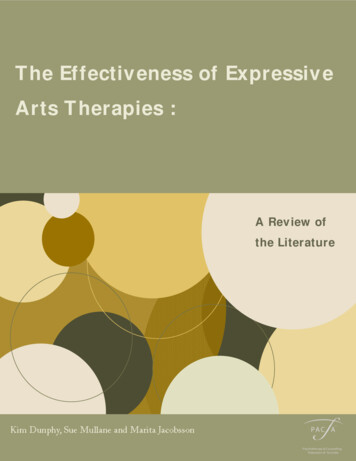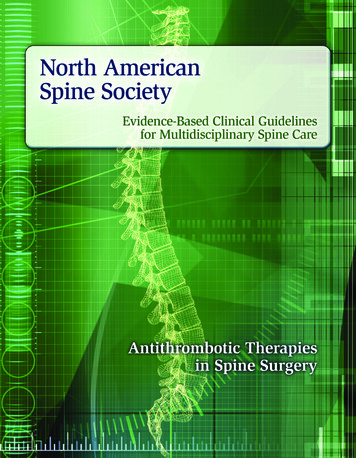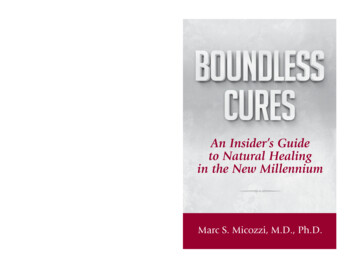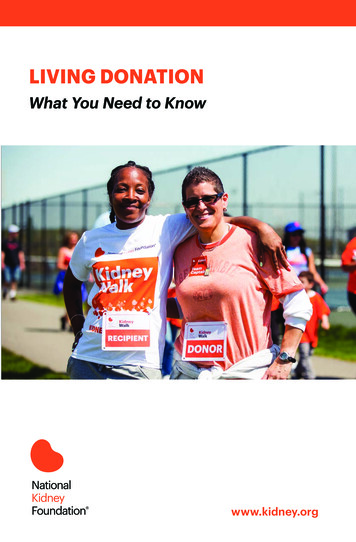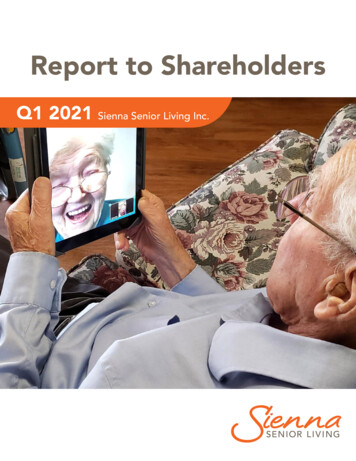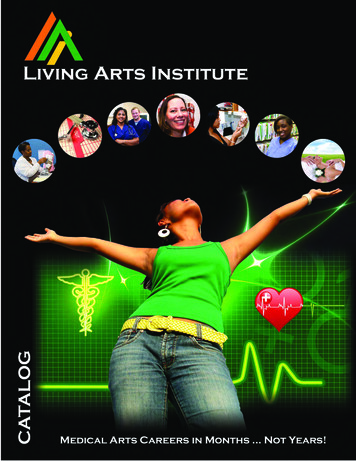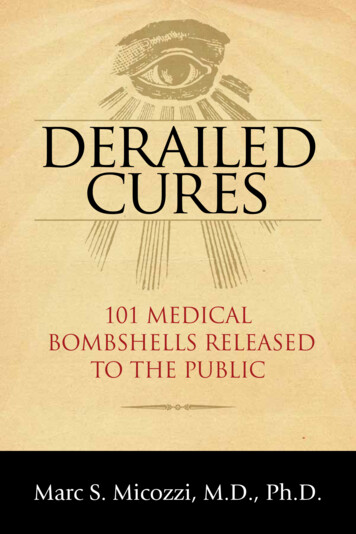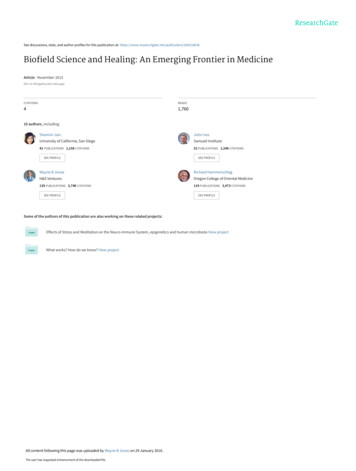
Transcription
See discussions, stats, and author profiles for this publication at: Biofield Science and Healing: An Emerging Frontier in MedicineArticle · November 2015DOI: 10.7453/gahmj.2015.106.supplCITATIONSREADS41,76010 authors, including:Shamini JainJohn IvesUniversity of California, San DiegoSamueli Institute41 PUBLICATIONS 1,158 CITATIONS52 PUBLICATIONS 1,246 CITATIONSSEE PROFILESEE PROFILEWayne B JonasRichard HammerschlagH&S VenturesOregon College of Oriental Medicine139 PUBLICATIONS 3,748 CITATIONS119 PUBLICATIONS 3,473 CITATIONSSEE PROFILESEE PROFILESome of the authors of this publication are also working on these related projects:Effects of Stress and Meditation on the Neuro-immune System, epigenetics and human microbiota View projectWhat works? How do we know? View projectAll content following this page was uploaded by Wayne B Jonas on 29 January 2016.The user has requested enhancement of the downloaded file.
Exploring the BiofieldeditorialExploring the BiofieldMary Jo Kreitzer, PhD, RN, FAAN; Rob Saper, MD, MPHContent designatedas open accessThose of us who have been in the field of integrative health and medicine for a decade or twovividly recall the era when there was greatenthusiasm and hope for therapeutic approaches thatfell into the realm of complementary and alternativemedicine. Healthcare clinicians and scientists worriedabout unsubstantiated claims and so-called therapeuticapproaches—historically popular among consumersbut largely untested by scientists—that might not behelpful and may even be harmful. Much has changedover the decades. The field was more controversial thanit is today due to growing public and private fundedresearch showing both what has promise and whatdoes not. Thirty years ago, there was little to no researchon acupuncture and mind-body approaches. If it hadbeen proposed that meditation could impact neurological and immune function and literally change thestructure and function of the brain, the idea wouldhave been considered ill informed and even outlandish.Science has caught up in this case, and breakthroughsin neuroscience have well documented the impact ofmeditation on the brain.The field of integrative health and medicine is stillrelatively new, and the evidence base, while growing, isnot mature. Though there is strong evidence for sometherapeutic approaches including acupuncture andmind-body therapies, there is very modest evidence inother areas such as the biofield. Global Advances inHealth and Medicine is very committed to inquiry, discovery, and open discourse. While this special issuewill be heralded by many as capturing breakthroughthinking and ideas, we acknowledge that others mayfind the evidence base weak or even implausible. Thisstrikes us as not unlike the reaction to acupuncture andmind-body approaches in the 1980s and early 1990s.This special issue of Global Advances in Health andMedicine brings together many of the experts in thenascent area of biofield theory. Articles cover a range oftopics including foundational concepts from physiology and physics, preclinical and clinical research, diagnostic and therapeutic devices, and opportunities andbarriers to mainstream integration. For example, Rubikand colleagues provide an overview of the history ofbiofield theory and the evolving terminology used todescribe it. The term originated out of a group convened by the National Institutes of Health (NIH) Officeof Alternative Medicine in the early 1990s in an attemptto provide an organizing schema for a wide range ofhealing practices, often referred to as energy medicineor bioenergetic therapies. Reiki, therapeutic touch, andqigong are several examples. Originally defined as aEditorial“massless field, not necessarily electromagnetic, thatsurrounds and permeates living bodies and affects thebody,” the biofield has evolved to a “multi-scale conceptthat offers a broader context for understanding biological regulation and information flow.” Gronowicz et alsummarize preclinical studies attempting to measurethe impact of healing intentions from experienced biofield practitioners. Suggestions on how future researchcan address methodological challenges, such as designing the best in vitro and in vivo models, standardizinginterventions, and improving reproducibility, areaddressed. Jain and colleagues summarize researchstudies on the clinical effects of biofield therapies,defined as “noninvasive, practitioner-assisted therapiesthat explicitly work with the biofield of both the practitioner and client to stimulate a healing response inthe client.” Pain and cancer are the conditions moststudied, with a few studies in the areas of arthritis,dementia, and heart disease. The authors call for larger,more rigorous interdisciplinary trials to allow betterunderstanding of clinical impact, cost-effectiveness,and mechanism.Complex interactions involving transfer of energyabound in daily life, medical care, and health. Many ofthese can be explained by well-established concepts inbiochemistry and physics. For example, photosynthesisuses light to help convert carbon dioxide and water intocarbohydrate and oxygen. Animals require food to manufacture energy in the form of adenosine triphosphate tocarry out vital functions involving motility and brainactivity. Well-established diagnostic techniques in medicine measure the electrical activity of the heart andbrain. Advanced imaging technology takes advantage ofdifferential effects of magnetic fields on water and tissue.Radiation is used to effectively treat cancer. Transcranialmagnetic stimulation is now being found to be effectivefor a wide range of neurological and psychiatric conditions. Deep brain electrical stimulation has had remarkable effects on movement disorders.Other interactions are more challenging to explain.We all have had the experience of having our wellbeingimpacted by the actions of others. The impact can benegative, such as when a patient encounters a healthcare provider who is stressed, distracted, or unnecessarily pessimistic. Conversely, we experience an improvement in our wellbeing when we are in the presence of acompassionate, caring person who holds our needs asmost important. Some less common phenomena areeven more difficult to explain scientifically: someonenot well known “reads our mind”; love that growsbetween two people; feeling “connected” to completeBiofield Science and Healing: Toward a Transdisciplinary ApproachCitationGlobal Adv Health Med.2015;4(suppl):3-4. DOI:10.7453/gahmj.2015.105.suppl3
Exploring the BiofieldTo view or downloadthe full-text article, 5.supplstrangers following a group meditation; and spiritualexperiences when one feels communion with a divineforce or being. Though our understanding of howthese interactions occur is increasing through diversedisciplines such as social psychology, neuroscience,and psychoneuroimmunology, much more remains tobe explained.Can all of these complex interactions—especiallythose involving energy healing modalities—beexplained by current well-established mechanisms?The biofield theory suggests provocatively that thesephenomena may be mediated, at least in part, by forces and processes yet to be discovered and well- characterized. In this way, biofield theory may becomelike many examples in the history of science and medicine where theories once considered implausiblebecome accepted through research and practice.Proponents of hand washing to prevent maternal sepsis, the role of bacteria in the pathogenesis of pepticulcer disease, and utility of beta blockers in congestiveheart failure were all looked upon incredulously. Asseveral of the contributors to this issue point out, perhaps rather than identifying a new heretofore undiscovered subtle field of energy that can be manipulatedfor healing, we can look upon the biofield theory as aunifying concept to encompass the wide variety ofphysical, emotional, social, and spiritual forces and factors that contribute to health and wellbeing.We hope this collection of papers will stimulatediscourse and research that over time will ultimatelylead to a better understanding of how to promotehealth and wellbeing.Mary Jo Kreitzer, PhD, RN, FAANRobert Saper, MD, MPHCo–Editors-in-ChiefGlobal Advances in Health and Medicine4Biofield Science and Healing: Toward a Transdisciplinary ApproachEditorial
Biofield Science and Healing: An Emerging Frontier in MedicineINTRODUCTIONBiofield Science and Healing: An Emerging Frontierin MedicineShamini Jain, PhD; John Ives, PhD; Wayne Jonas, MD; Richard Hammerschlag, PhD; David Muehsam, PhD; Cassandra Vieten,PhD; Daniel Vicario, MD; Deepak Chopra, MD, FACP; Rauni Pritten King, RN, MIH, CHTPI; Erminia Guarneri, MD, FACCAuthor AffiliationsConsciousness and Healing Initiative, San Diego,California (Drs Jain, Hammerschlag, and Muehsam);Department of Psychiatry, University of California, SanDiego (Dr Jain); Samueli Institute, Alexandria, Virginia(Drs Ives and Jonas); The Institute for Integrative Health,Baltimore, Maryland (Dr Hammerschlag); NationalInstitute of Biostructures and Biosystems, VID ArtScience, Bologna, Italy (Dr Muehsam); Institute of NoeticSciences, Petaluma, California, and California PacificMedical Center Research Institute (Dr Vieten); San DiegoCancer Research Institute and Moores Cancer Center,University of California, San Diego (Dr Vicario);Department of Family Medicine and Public Health,University of California, San Diego, the Chopra Centerfor Wellbeing, Chopra Foundation, and Kellogg Schoolof Management, Evanston, Illinois (Dr Chopra); MiragloFoundation, San Diego, California, Guarneri IntegrativeHealth, and Academy of Integrative Health andMedicine, Duluth, Minnesota (Ms King and Dr Guarneri).We live in an age of unparalleled technological and scientific progress, juxtaposed witha cascading series of poor social, health, andenvironmental choices that could bring our species tothe brink of catastrophe. Within the past 100 yearsalone, we have created significant advances in technologies to better control disease outbreaks, extend ourlifespan, enhance global communication, increase ourwork productivity, and improve our overall quality oflife. At the same time, we are facing major healthcarecrises including diabetes, cardiovascular disease, cancer, and mental illness. Despite our best efforts andtechnological advances, we have not yet conqueredthese and other life- and health-interfering disorders. Inaddition, health disparities are increasing and the 100year rise in life expectancy is flattening.1 This continuance of human suffering, in the face of all our advancements, is leading to substantial and exponentiallygrowing costs to individuals and to society.A key ingredient in the recipe for advancing theevolution of human health is self-empowerment,which can only emerge with a clear recognition ofone’s own capacity for healing. Examples from clinicaland research areas such as mind-body medicine, placebo, psychoneuroimmunology, and neuroscience,remind us that our capacity to activate our own internal healing response is within our human capabilities.IntroductionJust a few decades ago, the theory that the nervous system was directly connected to the immune system washighly controversial; today, it is mainstream science—with recent scientific studies uncovering deeper discoveries of vagal-immune and vagal-microbiome communications,2,3 and a most recent scientific reportsuggesting functional lymphatic vessels may residewithin the brain.4 The idea that our mental and emotional states impact our immune and cardiovascularsystems in a manner that could influence disease progression as well as health, has moved from fringe tofact,5,6 thanks to decades of careful, interdisciplinaryresearch by scientists who continued to test their initially unpopular hypotheses. These scientists’ empirical advances founded and advanced the now wellestablished field of psychoneuroimmunology (PNI).Despite these groundbreaking scientific discoveries, translation of these data into interventions forpatients to facilitate their own health and healingremain limited. To empower healthcare providers,their patients, and the general public to facilitate theirown healing requires an advancement in knowledgeand practice that can only occur through the multidisciplinary integration of perspectives on mechanisms ofhealing and health maintenance. Such an integrationis rather daunting to embark upon, given the currentculture of academic and clinical specialization, as weare taught to specialize early in our careers as academics and clinicians, and rarely have the opportunity forcross-disciplinary dialogue.While specialization is intended to lead to discoveries through complete focus and immersion in a single area, the emergence of significant breakthroughs inscience and medicine has often occurred as a result ofinterdisciplinary communication and collaboration.Indeed, Dr Robert Ader, cofounder of PNI, understoodthat the advances in his field would begin with interdisciplinary inquiry and later lead to a dissolution ofarbitrary borders between disciplines, leading to amore global, networked understanding of health:Content designatedas open accessCitationGlobal Adv Health Med.2015;4(suppl):5-7.DOI: 10.7453/gahmj.2015.106.supplCorrespondenceShamini Jain, PhDsjain@ucsd.eduKey WordsBiofield, biofield science,healing, medicine, psychoneuroimmunology,bioelectromagnetics,Reiki, healing touch,therapeutic touchDisclosuresThe authors completedthe ICMJE Form forDisclosure of PotentialConflicts of Interest. DrMuehsam disclosed thathe is a consultant for RioGrande Neurosciences.Dr Chopra disclosed thathe is co-owner of theChopra Center forWellbeing as well aspayments and royaltiesfor activities outsidethe submitted work.Dr Guarneri disclosedthat she is a consultantfor Atlantic HealthSystems outside thesubmitted work. Theother authors had noconflicts to disclose.Disciplinary boundaries and the bureaucraciesthey spawned are biological fictions that canrestrict imagination and the transfer and application of technologies. They lend credence toWerner Heisenberg’s assertion that “What weobserve is not nature itself, but nature exposedto our method of questioning.” Our own language, too, must change. The signal molecules ofBiofield Science and Healing: Toward a Transdisciplinary Approach5
Biofield Science and Healing: An Emerging Frontier in Medicinethe nervous and immune systems are expressedand perceived by both systems. Therefore, itmay no longer be appropriate to speak of “neurotransmitters” and “immunotransmitters.”Also, to speak of links or channels of communication between the nervous and immune systems perpetuates the myth that these arediscrete systems (or disciplines). On the contrary, the evidence indicates that relationshipsbetween so-called “systems” are as importantand, perhaps, more important than relationships within “systems”; that so-called “systems”are critical components of a single, integratednetwork of homeostatic mechanisms.”7In the latter part of this quote, Ader suggests thatwhat we have viewed as discrete systems are in factparts of a larger, holistic network that guides anorganism’s homeostasis. We propose that such a network may be found in what is currently being termedthe biofield, a field of energy and information thatreflects and guides the homeodynamic regulation of aliving system, and as such influences and is influenced by consciousness.While the term biofield itself is fairly new (coinedin 1992 at a National Institutes of Health meeting; seeRubik et al, this issue), discussion on the importanceand role of consciousness, energy, and information tocreate and guide emotional, mental, and physical functioning has been described by numerous diverse cultures and used in medical systems for thousands ofyears (Jain et al, this issue). Despite the careful definition and description of biofield-related concepts inthese cultures, our modern descriptions and understandings of such concepts and how they may relate tohealing processes are still in their nascent stages. As isevident in this Special Issue, even among biofield science researchers, there is disagreement about whethervitalistic concepts such as chi and prana are essentialfor describing the biofield, whether the biofield can bereduced to bioelectromagnetic emanations on differentlevels of scale, or whether the understanding of thebiofield at its core demands a new understanding ofphysics and biology that incorporate models of consciousness (eg, see papers by Jain et al, Rubik et al,Kafatos et al in this issue). Further, it is not well understood whether mechanisms underlying results fromproximally practiced biofield therapies in pre-clinicaland clinical studies (see Gronowicz, Bengston, andYount and Jain et al, in this issue) are at all related tolaboratory studies examining the effects of distanthealing intention (see Radin, Schlitz, and Baur, thisissue). A thorough understanding of how biofieldtherapies might “get under the skin” and affect physiological processes is still needed (see Hammerschlag etal, this issue). Significant issues remain in understanding whether practitioners’ concepts of the biofield arealigned with researchers’, as well as with each others’(see Warber et al, this issue). The questions of how to6Biofield Science and Healing: Toward a Transdisciplinary Approachbest integrate biofield practitioners into healthcaresystems are crucial to address (see Guarneri and King,this issue). In addition, the increasing use of devicesthat are used to influence aspects of the biofield toenhance a healing response (see Muehsam et al, thisissue), represents yet another frontier with respect toresearch and clinical application.Biofield science, then, currently finds itself in ahighly controversial, not-yet-well-understood, andsometimes academically contentious environment.Regardless of the evidence, this area is viewed by manyscientists as too “fringe” to merit serious consideration(see Hufford et al, this issue for discussion of paradigmshifts). Current funding for the field of biofield scienceis more strongly directed toward industry applicationsand less toward basic science and clinical application.Given the current controversies, challenges to conceptualization and measurement, and general lack offunding, why should we consider advancing the field ofbiofield science? First, the roots of biofield concepts andpractice have persisted for thousands of years andremain the basis for many medical interventions andself-healing practices across the globe. Biofield conceptsare rooted in indigenous schools of medicine, as evidenced by “whole medical systems” practices such asChinese, Tibetan, Native American, African, andAyurvedic medicine. The ongoing use of biofield-basedhealing practices, in terms of both self-practice andpractitioner-assisted modalities, has continued to flourish over time, with increasing evidence to support theiruse in certain difficult-to-treat clinical populations,with no known adverse effects (see Jain et al, this issue).Arguably, the use of biofield systems and therapiesover millennia, while provocative, may not in and ofitself warrant scientific investigation. However, inaddition to this preponderance and longevity in clinical application based on concepts akin to biofield,recent empirical advances in bioelectromagnetics suggest that perturbation of electromagnetic aspects of thebiofield (involving very weak physical energies) cansubstantially impact health processes (see Muehsam etal, this issue). These findings are driving industry innovation. The application of bioelectromagnetics in psychiatric and neurodegenerative disorders is growingrapidly. The global industry of neuromodulation (theuse of externally applied electromagnetic signals fortreatment of central nervous system-related disorders)is predicted to move from 2015 estimates of 3.65 billion to 6.20 billion by 2020.8 Some scientists haveheralded “electroceuticals” as the next wave of “bigpharma,” with the National Institutes of Health as wellas several large pharmaceutical industries investingsignificant resources in mapping the body’s bioelectromagnetic fields for development of further devices formedical application.9,10 Finally, some of theseapproaches are becoming more readily available toconsumers directly: over-the-counter neuromodulation products are now being marketed heavily by certain groups, with some questioning the ethics andIntroduction
Biofield Science and Healing: An Emerging Frontier in Medicinesafety of such use.11 To this end, it is essential that boththe gross and subtle aspects of the biofield be mappedas clearly as possible by varied approaches.In the spirit of fostering collaborative inquiry andaccelerating strong empirical research in the area ofbiofield science, several organizations came together tosponsor an interdisciplinary scholarly meeting, termed“Biofield Science and Healing.” The meeting, sponsoredby the Miraglo Foundation, the Institute of NoeticSciences, the Chopra Foundation, and the SamueliInstitute, was held at the Pacific Pearl Center in La Jolla,California, in September 2014. As respected leaderswho have been forwarding the science and practice ofbiofield-related areas for decades, each of these organizations saw the value in a collaborative acceleration ofbiofield science and practice.Invited researchers and scholars represented awide range of scientific disciplines, including biophysics, physics, biology, clinical psychology, psychoneuroimmunology, psychoneuroendocrinology, neurosciences, engineering, and medicine. They were joined byleading biofield practitioners who were specificallyselected for having been involved in scientific studiesof biofield therapies.This special issue on Biofield Science and Healingreflects the rich, ongoing exchanges within this interdisciplinary group. It is hoped that this issue will catalyze discussion and advance multidisciplinary inquiry into biofield science. This multidisciplinary effortwill be supported through the emergent collaborativebackbone organization,12 the Consciousness andHealing Initiative (CHI), which fosters interdisciplinary science and provides scientifically-based educational resources in consciousness and healing acrossinstitutions and disciplines.Biofield research is certainly a “work in progress”and is not without its share of scientific complexities.However, its potential payoff in terms of service tosociety could be transformative. This special issue onBiofield Science and Healing is the reflection of agrowing interdisciplinary, collaborative effort toadvance this rapidly evolving science and discipline.We look forward to collectively supporting theseefforts and facilitating the individual and societalhealth empowerment that may emerge with a clearerunderstanding of the biofield.6.7.8.9.10.11.12.render.fcgi?artid 3707393&tool pmcentrez&rendertype abstract. AccessedOctober 6, 2015.Taylor AG, Goehler LE, Galper DI, Innes KE, Bourguignon C. Top-down andbottom-up mechanisms in mind-body medicine: development of an integrative framework for psychophysiological research. Explore (NY).2010;6(1):29-41. doi:10.1016/j.explore.2009.10.004.Ader R. Historical perspectives on psychoneuroimmunology. In: FriedmanH, Klein TW, Friedman AL, eds. Psychoneuroimmunology, Stress, andInfection. Boca Raton: CRC Press; 1996:1-24.Neuromodulation market by technology (deep brain stimulation, spinalcord stimulation, transcranial magnetic stimulation) & by application(depression, Parkinson’s, tinnitus, alzheimer’s, epilepsy, ischemia, obesity)Trends & Global Forecast to 2020. 2015. neuromodulation.GSK. Bioelectronics. onics/. Accessed October 6, 2015.Reardon S. Electroceuticals spark interest. Nature. 2014;511(7507):18.Cabrera LY, Evans EL, Hamilton RH. Ethics of the electrified mind: definingissues and perspectives on the principled use of brain stimulation in medical research and clinical care. Brain Topogr. 2014;27(1):33-45.Turner S, Merchant K, Kania J, Martin E. Understanding the value of backbone organizations in collective impact: part 2. Stanford Soc Innov Rev.2012. http://ssir.org/articles/entry/understanding the value of backboneorganizations in collective impact 2. Accessed October 6, 2015.To view or downloadthe full-text article, 6.supplReferences1. National Center for Biotechnology Information. US health in internationalperspective: shorter lives, poorer health. http://www.ncbi.nlm.nih.gov/pubmed/?term Shorter Lives%2C Poorer Health from 2013 by Steven Wolff. Accessed September 25, 2015.2. Sundman E, Olofsson PS. Neural control of the immune system. Adv PhysiolEduc. 2014;38(2):135-9. i?artid 4056170&tool pmcentrez&rendertype abstract. AccessedSeptember 25, 2015.3. Dunn AJ. Nervous and immune system interactions. In: eLS. Chichester,England: John Wiley & Sons Ltd; 2005.4. Louveau A, Smirnov I, Keyes TJ, et al. Structural and functional features ofcentral nervous system lymphatic vessels. Nature. 2015;523(7560):337-41.doi:10.1038/nature14432.5. Slavich GM, Cole SW. The emerging field of human social genomics. ClinPsychol Sci. 2013 Jul;1(3):331-48. ionBiofield Science and Healing: Toward a Transdisciplinary Approach7
Biofield Science and Healing: History, Terminology, and Conceptsoriginal articleContent designatedas open accessCitationGlobal Adv Health Med.2015;4(suppl):8-14.DOI: 10.7453/gahmj.2015.038.supplCorrespondenceBeverly Rubik, PhDbrubik@earthlink.netKey WordsBiofield,bioelectromagnetics,biological field,electromagnetic fields,energy medicine,healingDisclosuresThe authors completedthe ICMJE Form forDisclosure of PotentialConflicts of Interest anddisclosed the following:Dr Rubik is a boardmember of andconsultant for theInstitute for FrontierScience; Dr Muehsam isa consultant for RioGrande Neurosciences;and Dr Jain received agrant from WestreichFoundation—all outsidethe submitted work.Dr Hammerschlag hadno conflicts to disclose.Biofield Science and Healing: History, Terminology,and ConceptsBeverly Rubik, PhD; David Muehsam, PhD; Richard Hammerschlag, PhD; Shamini Jain, PhDAuthor AffiliationsInstitute for Frontier Science, Oakland, California;Integrative Health Studies, California Institute of IntegralStudies, San Francisco; College of Mind-Body Medicine,Saybrook University, Oakland, California; EnergyMedicine University, Sausalito, California (Dr Rubik).Visual Institute of Developmental Arts and Sciences,National Institute of Biostructures and Biosystems,Bologna, Italy (Dr Muehsam). The Institute for IntegrativeHealth, Baltimore, Maryland; Oregon College of OrientalMedicine, Portland (Dr Hammerschlag). Department ofPsychiatry and Center for Integrative Medicine, Universityof California, San Diego; Consciousness and HealingInitiative, San Diego (Dr Jain).ABSTRACTBiofield science is an emerging field of study thataims to provide a scientific foundation for understanding the complex homeodynamic regulation of livingsystems. By furthering our scientific knowledge of thebiofield, we arrive at a better understanding of the foundations of biology as well as the phenomena that havebeen described as “energy medicine.” Energy medicine,the application of extremely low-level signals to thebody, including energy healer interventions and bioelectromagnetic device-based therapies, is incomprehensible from the dominant biomedical paradigm of“life as chemistry.” The biofield or biological field, acomplex organizing energy field engaged in the generation, maintenance, and regulation of biological homeodynamics, is a useful concept that provides the rudiments of a scientific foundation for energy medicineand thereby advances the research and practice of it. Anoverview on the biofield is presented in this paper, witha focus on the history of the concept, related terminology, key scientific concepts, and the value of the biofieldperspective for informing future research.INTRODUCTIONMedicine is in transition. Conventional biomedicine is giving way to an expanded, integrative medicalmodel that emphasizes healthcare as well as illness care,treats people not just diseases, and incorporates multipletherapeutic approaches, old and new, to offer patientsgreater choice.1 This emerging model questions thedominant biomedical paradigm of molecular reductionism that focuses on genes, proteins encoded by genes,and molecules synthesized by proteins and that is based8Biofield Science and Healing: Toward a Transdisciplinary Approachon an inherent belief that complex systems can beunderstood by identifying their components. By contrast, an integrative model of health and medicine appreciates the complexity of our biology, which can give riseto emergent phenomena that are not, in general, predictive from isolated parts. Such a model also views healthcare from several perspectives beyond the molecularapproach, including what has been called energy medicine.2 Advances in biophysics, biology, psychology, andthe developing fields of mind-body research such aspsychoneuroimmunology and psychosocial genomicshave helped substantially to form a foundation for thisexpanded integrative medical model.In addition to biochemical signals, the idea thatliving systems generate and respond to energy fields asintegral aspects of physiological regulation reflects aconvergence of several disparate paths. Numerousspiritual traditions describe modes and pathways ofenergy within and surrounding the physical body (Jainet al, 2015, this issue). Many complementary and alternative medicine (CAM) therapies utilize variants of“laying-on-of-hands” and other minimally invasiveprocedures to improve endogenous
See discussions, stats, and author pr ofiles for this public ation at : https://www.researchgate.net /publication/284216836 Biofield Science and Healing: An Emerging .
